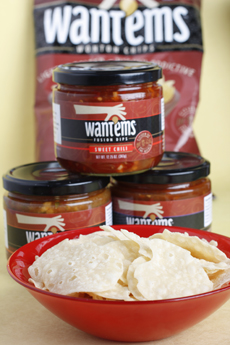|
When we were growing up, chips meant potato chips or corn chips.
Today, the chip aisle is bursting with choices. There are bean chips, nut chips, plantain chips, rice chips, tortilla chips and vegetable chips.
And now, there are wonton chips.
Inspired by the wonton strips served at Chinese restaurants (great for dipping in hot mustard or duck sauce), the product was developed by two friends who had enjoyed many a meal in Boston’s Chinatown.
Unlike the darker colored restaurant wonton strips, Want’ems are pale and light in texture, made from whole grain wheat flour and fried in canola oil. They taste like wonton strips “lite.”
The all-natural chips are available in Original and Asian BBQ. The BBQ has added hints of soy sauce, garlic and brown sugar.
|
|

The new chip in town: Want’ems wonton
chips. Photo by Jaclyn Nussbaum | THE
NIBBLE. |
The company also makes three varieties of sweet dipping sauce, but we prefer hot mustard. Try Colman’s Mustard, available in prepared and the original powdered form.
Want’ems is aiming for national distribution, so they may not be easy to find at your nearest store. But they’re available on Amazon.
Learn more about Want’ems at Wantems.com.
Find reviews of our favorite snacks in our Gourmet Snacks Section.
|







